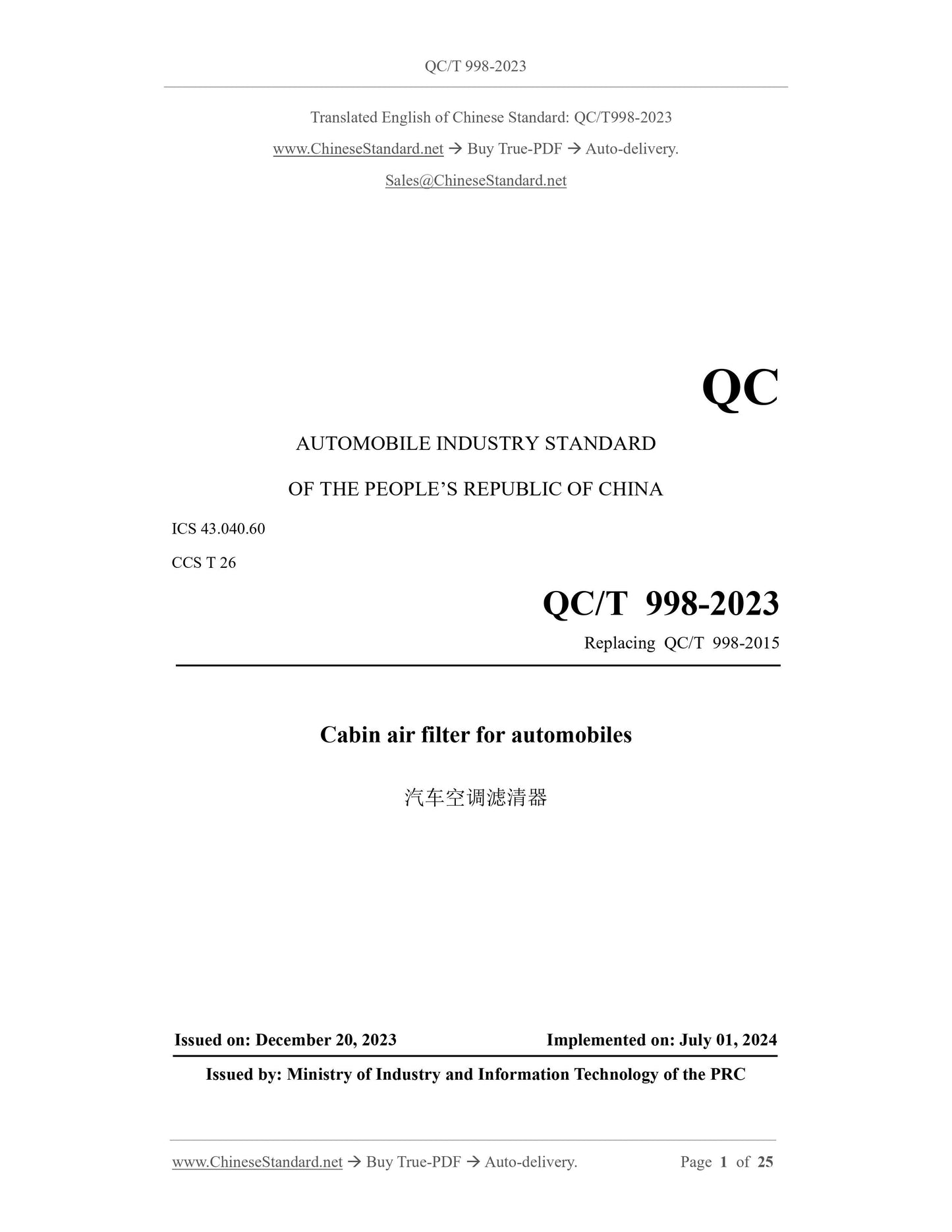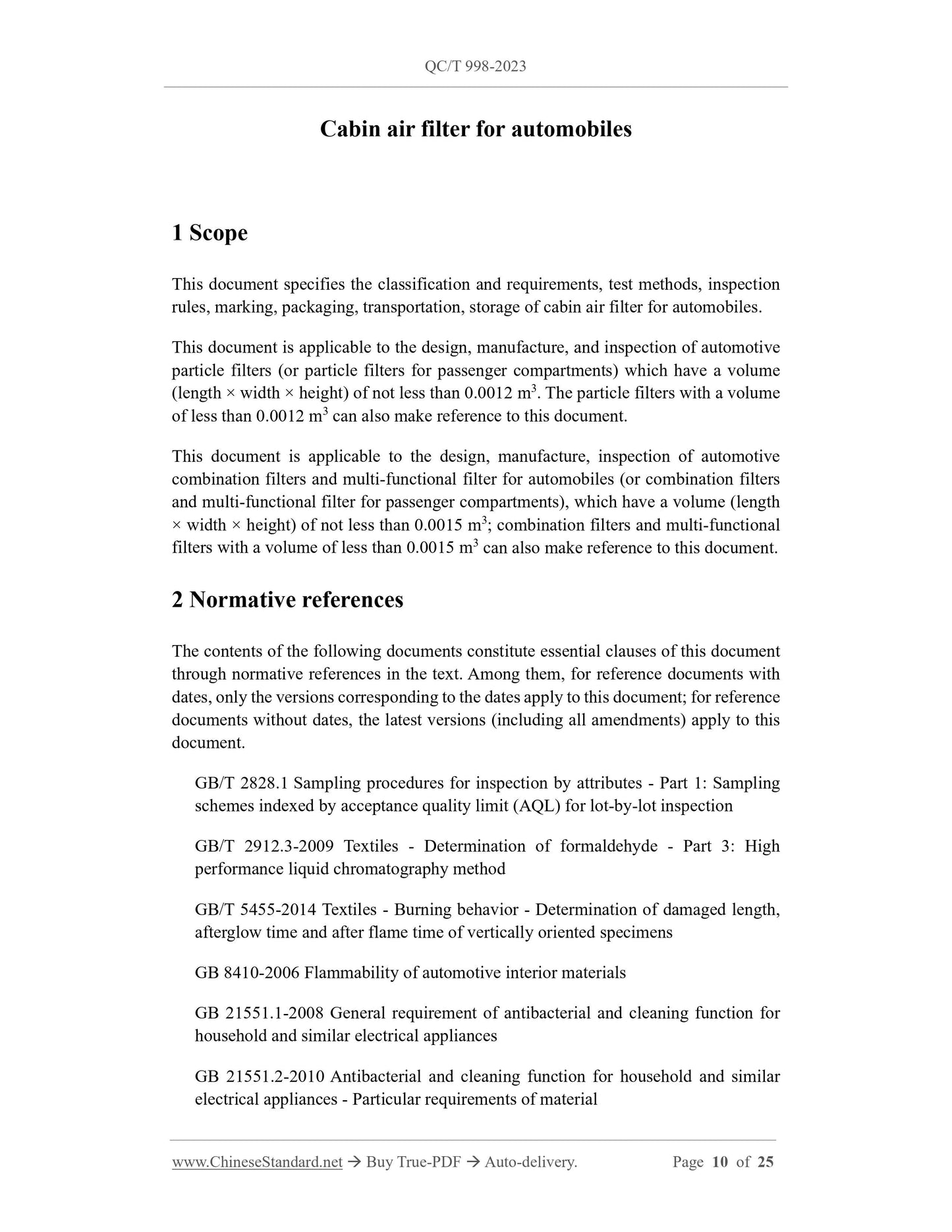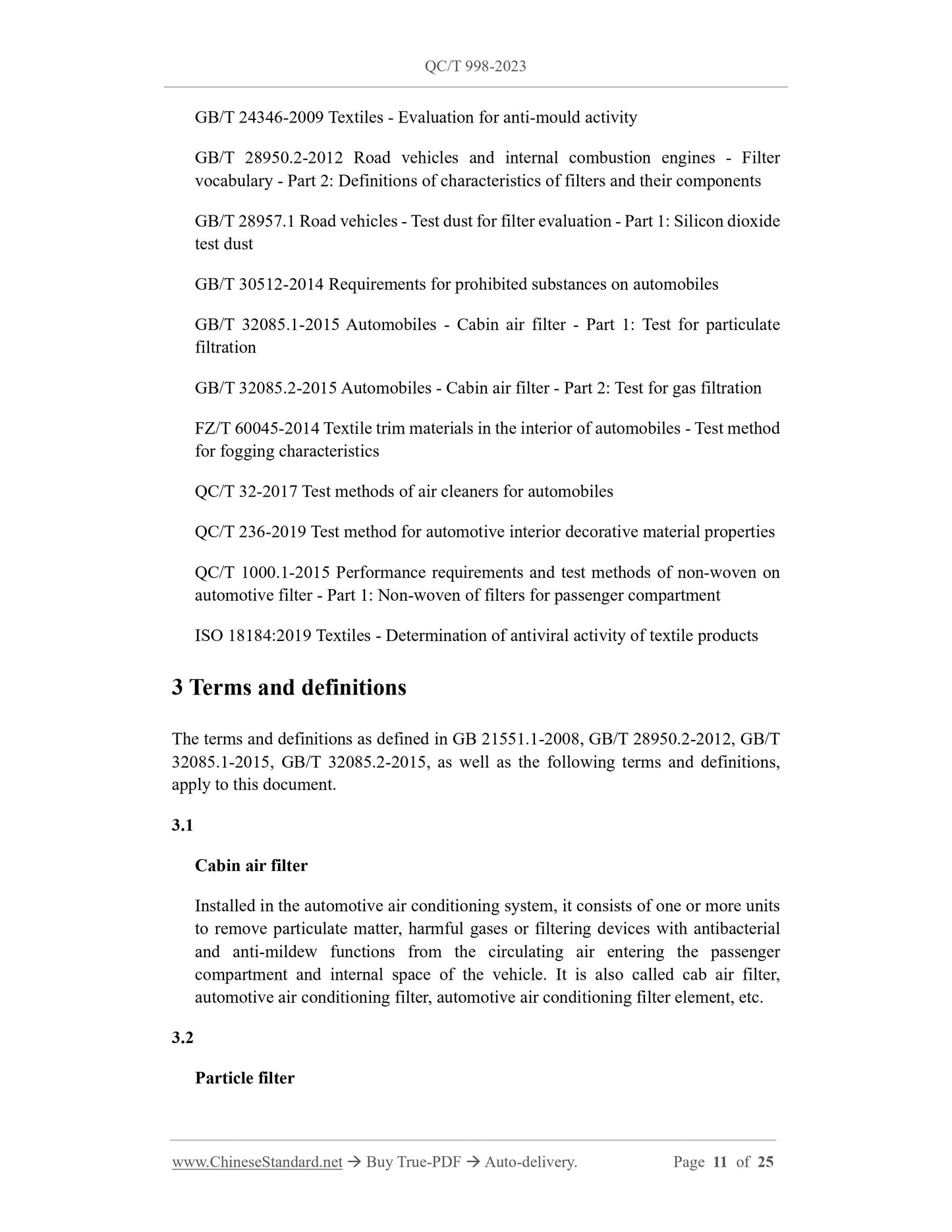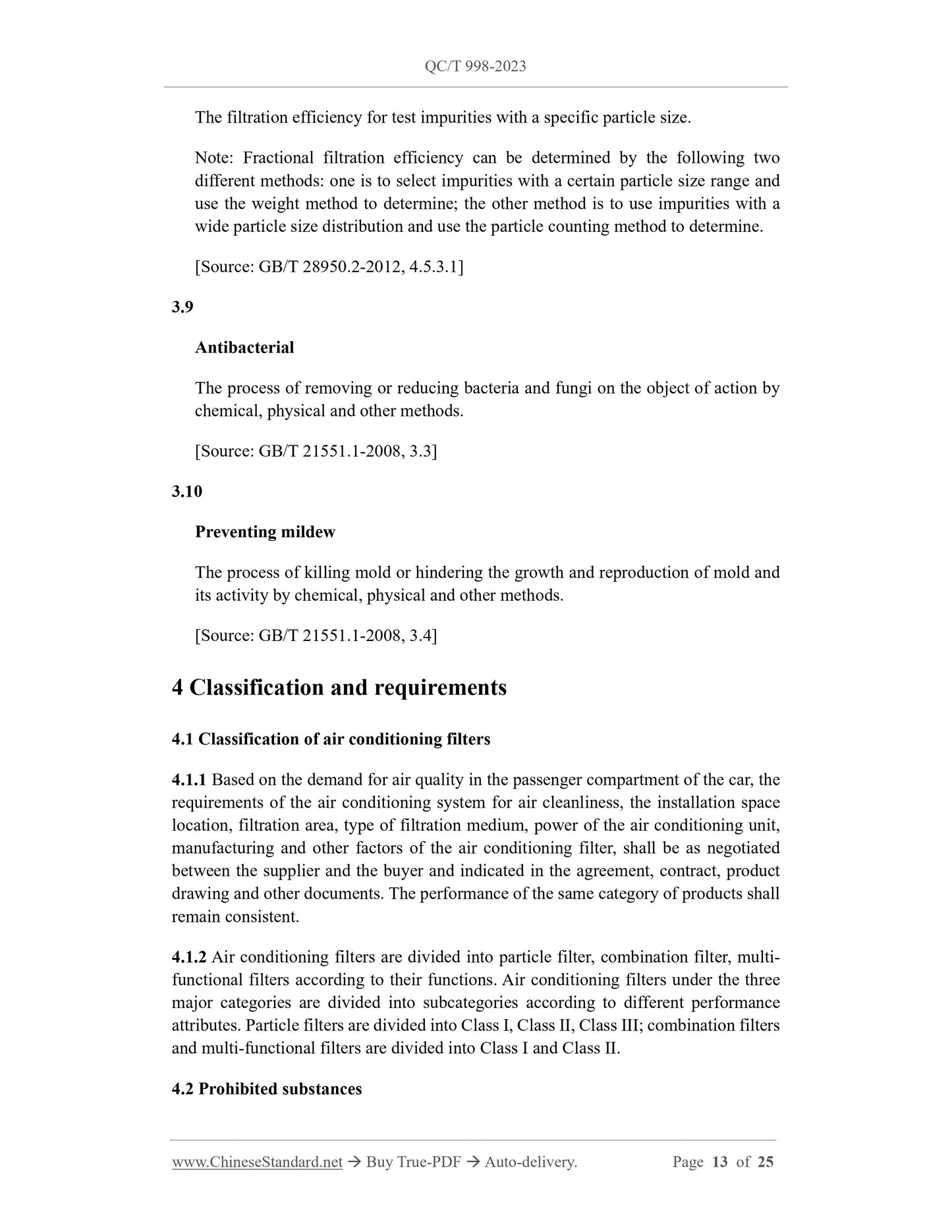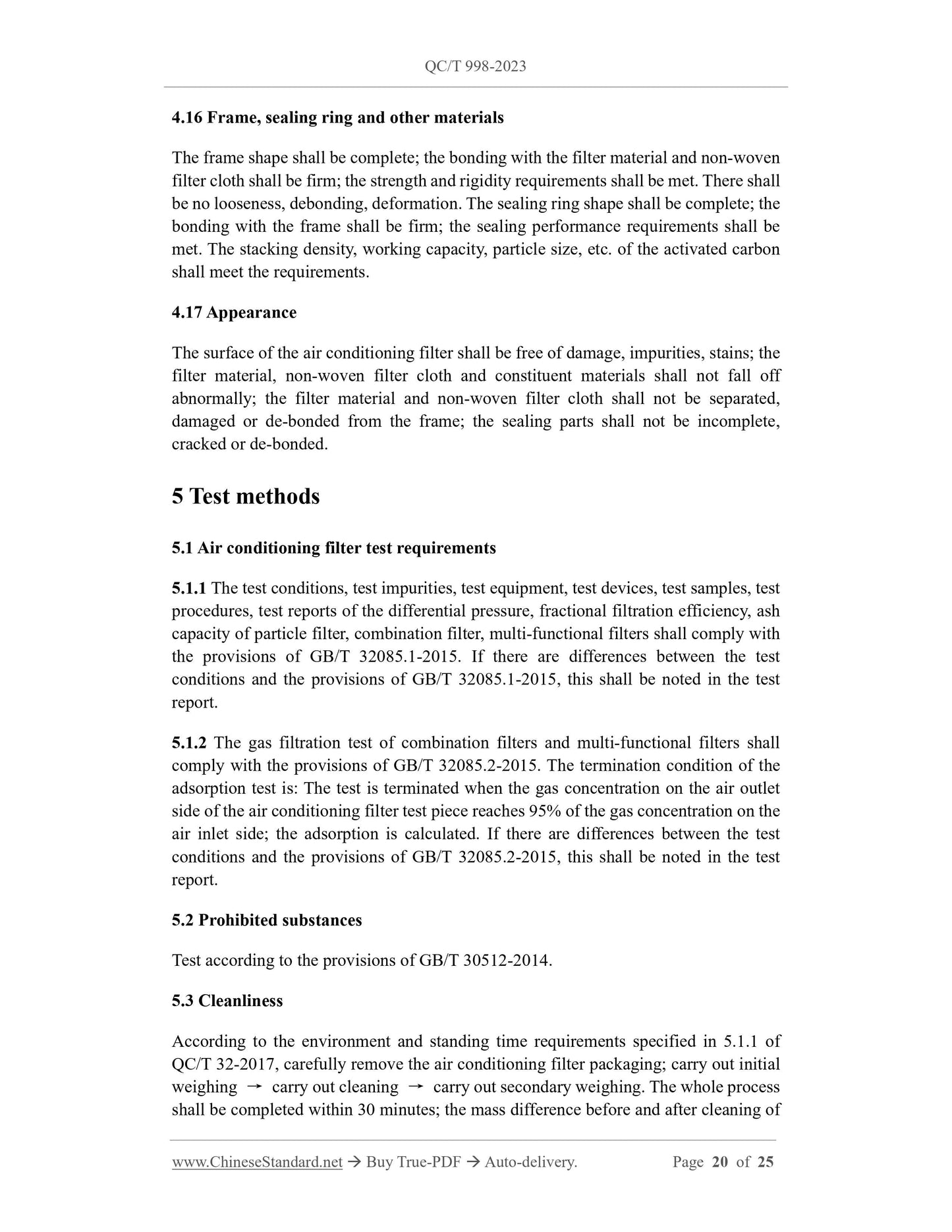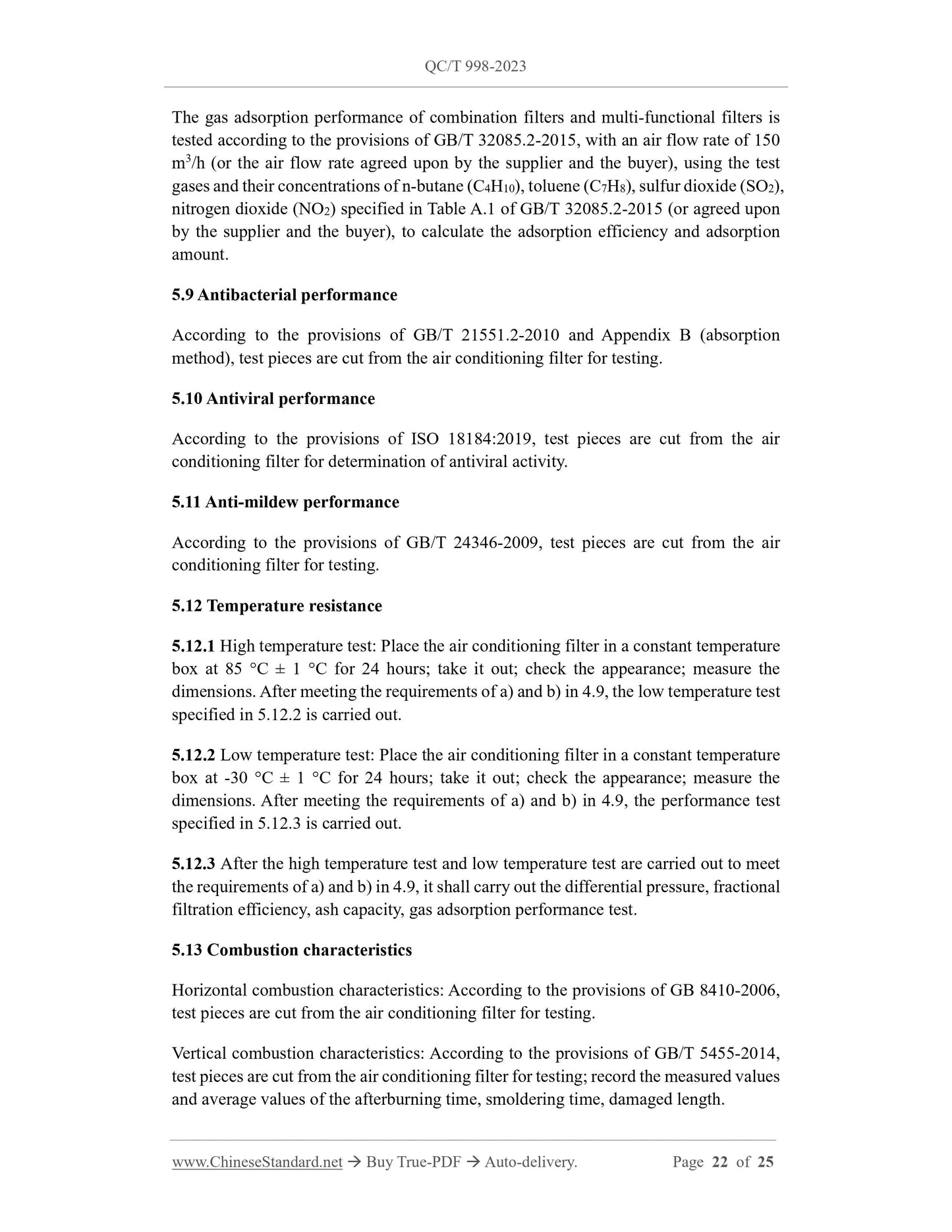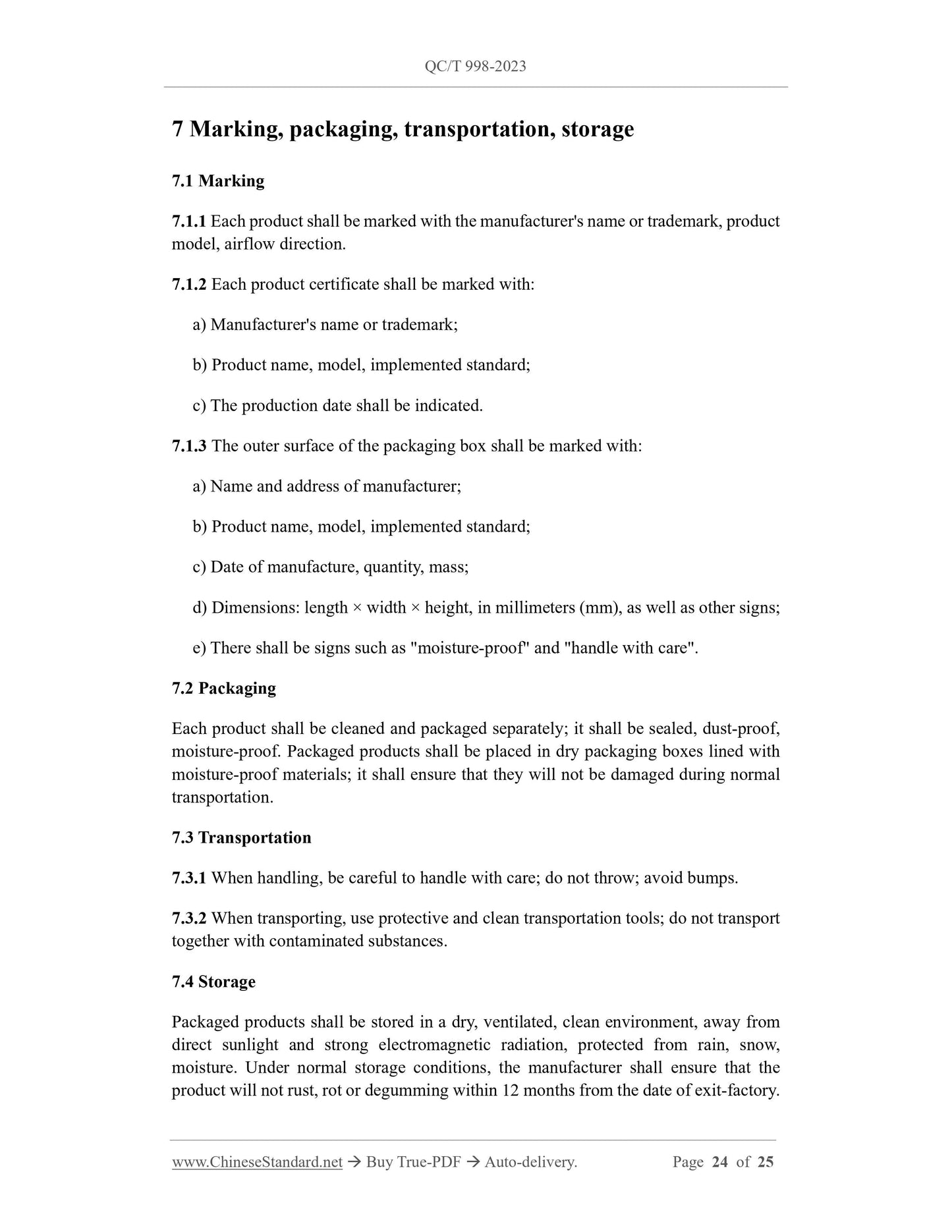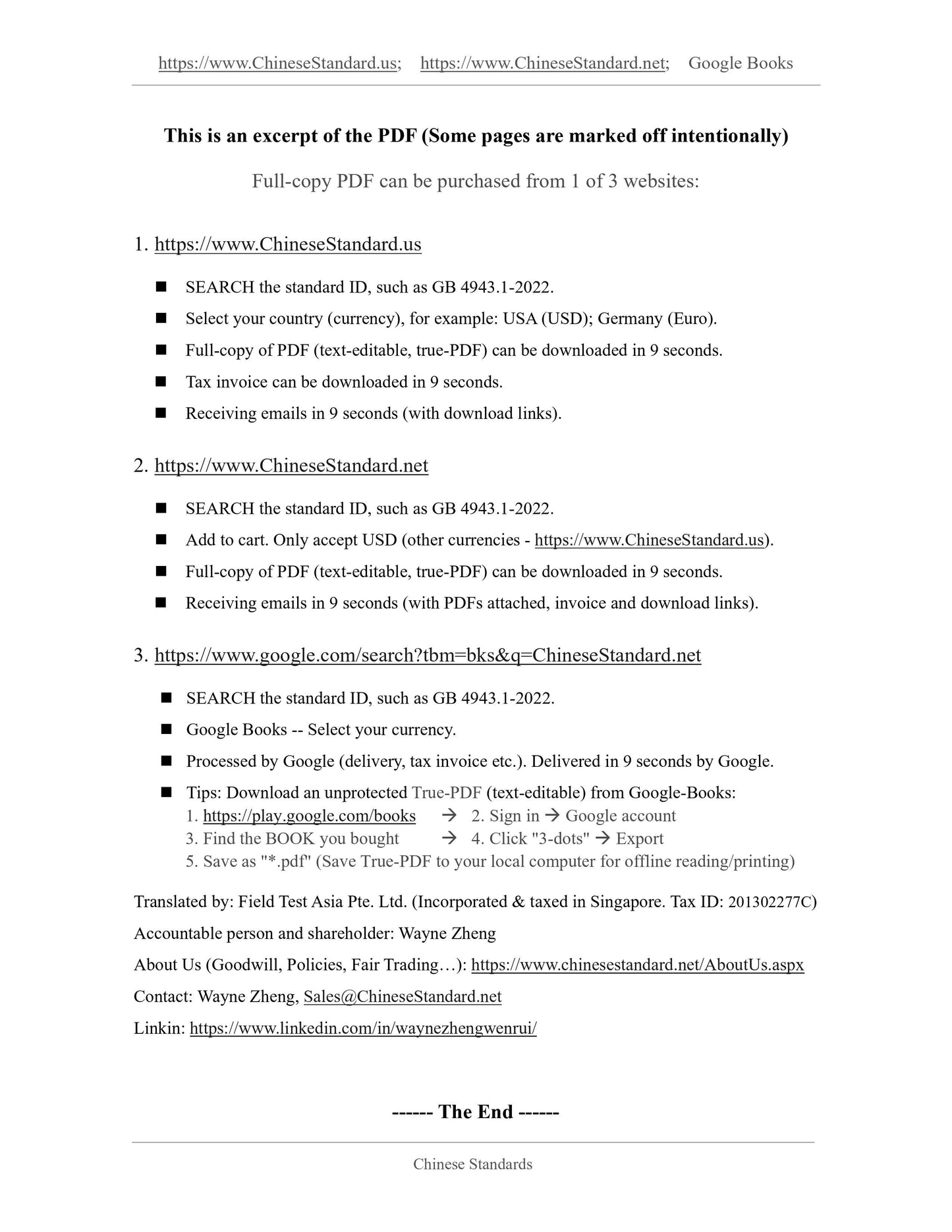1
/
の
9
PayPal, credit cards. Download editable-PDF and invoice in 1 second!
QC/T 998-2023 English PDF (QCT998-2023)
QC/T 998-2023 English PDF (QCT998-2023)
通常価格
$320.00 USD
通常価格
セール価格
$320.00 USD
単価
/
あたり
配送料はチェックアウト時に計算されます。
受取状況を読み込めませんでした
Delivery: 3 seconds. Download true-PDF + Invoice.
Get QUOTATION in 1-minute: Click QC/T 998-2023
Historical versions: QC/T 998-2023
Preview True-PDF (Reload/Scroll if blank)
QC/T 998-2023: Cabin air filter for qutomobiles
QC/T 998-2023
QC
AUTOMOBILE INDUSTRY STANDARD
ICS 43.040.60
CCS T 26
Replacing QC/T 998-2015
Cabin air filter for automobiles
ISSUED ON. DECEMBER 20, 2023
IMPLEMENTED ON. JULY 01, 2024
Issued by. Ministry of Industry and Information Technology of the PRC
Cabin air filter for automobiles
1 Scope
This document specifies the classification and requirements, test methods, inspection
rules, marking, packaging, transportation, storage of cabin air filter for automobiles.
This document is applicable to the design, manufacture, and inspection of automotive
particle filters (or particle filters for passenger compartments) which have a volume
(length × width × height) of not less than 0.0012 m3.The particle filters with a volume
of less than 0.0012 m3 can also make reference to this document.
This document is applicable to the design, manufacture, inspection of automotive
combination filters and multi-functional filter for automobiles (or combination filters
and multi-functional filter for passenger compartments), which have a volume (length
× width × height) of not less than 0.0015 m3; combination filters and multi-functional
filters with a volume of less than 0.0015 m3 can also make reference to this document.
2 Normative references
The contents of the following documents constitute essential clauses of this document
through normative references in the text. Among them, for reference documents with
dates, only the versions corresponding to the dates apply to this document; for reference
documents without dates, the latest versions (including all amendments) apply to this
document.
GB/T 2828.1 Sampling procedures for inspection by attributes - Part 1.Sampling
schemes indexed by acceptance quality limit (AQL) for lot-by-lot inspection
GB/T 2912.3-2009 Textiles - Determination of formaldehyde - Part 3.High
performance liquid chromatography method
GB/T 5455-2014 Textiles - Burning behavior - Determination of damaged length,
afterglow time and after flame time of vertically oriented specimens
GB 8410-2006 Flammability of automotive interior materials
GB 21551.1-2008 General requirement of antibacterial and cleaning function for
household and similar electrical appliances
GB 21551.2-2010 Antibacterial and cleaning function for household and similar
electrical appliances - Particular requirements of material
GB/T 24346-2009 Textiles - Evaluation for anti-mould activity
GB/T 28950.2-2012 Road vehicles and internal combustion engines - Filter
vocabulary - Part 2.Definitions of characteristics of filters and their components
GB/T 28957.1 Road vehicles - Test dust for filter evaluation - Part 1.Silicon dioxide
test dust
GB/T 30512-2014 Requirements for prohibited substances on automobiles
GB/T 32085.1-2015 Automobiles - Cabin air filter - Part 1.Test for particulate
filtration
GB/T 32085.2-2015 Automobiles - Cabin air filter - Part 2.Test for gas filtration
FZ/T 60045-2014 Textile trim materials in the interior of automobiles - Test method
for fogging characteristics
QC/T 32-2017 Test methods of air cleaners for automobiles
QC/T 236-2019 Test method for automotive interior decorative material properties
QC/T 1000.1-2015 Performance requirements and test methods of non-woven on
automotive filter - Part 1.Non-woven of filters for passenger compartment
ISO 18184.2019 Textiles - Determination of antiviral activity of textile products
3 Terms and definitions
The terms and definitions as defined in GB 21551.1-2008, GB/T 28950.2-2012, GB/T
32085.1-2015, GB/T 32085.2-2015, as well as the following terms and definitions,
apply to this document.
3.1
Cabin air filter
Installed in the automotive air conditioning system, it consists of one or more units
to remove particulate matter, harmful gases or filtering devices with antibacterial
and anti-mildew functions from the circulating air entering the passenger
compartment and internal space of the vehicle. It is also called cab air filter,
automotive air conditioning filter, automotive air conditioning filter element, etc.
3.2
Particle filter
The filtration efficiency for test impurities with a specific particle size.
Note. Fractional filtration efficiency can be determined by the following two
different methods. one is to select impurities with a certain particle size range and
use the weight method to determine; the other method is to use impurities with a
wide particle size distribution and use the particle counting method to determine.
[Source. GB/T 28950.2-2012, 4.5.3.1]
3.9
Antibacterial
The process of removing or reducing bacteria and fungi on the object of action by
chemical, physical and other methods.
[Source. GB/T 21551.1-2008, 3.3]
3.10
Preventing mildew
The process of killing mold or hindering the growth and reproduction of mold and
its activity by chemical, physical and other methods.
[Source. GB/T 21551.1-2008, 3.4]
4 Classification and requirements
4.1 Classification of air conditioning filters
4.1.1 Based on the demand for air quality in the passenger compartment of the car, the
requirements of the air conditioning system for air cleanliness, the installation space
location, filtration area, type of filtration medium, power of the air conditioning unit,
manufacturing and other factors of the air conditioning filter, shall be as negotiated
between the supplier and the buyer and indicated in the agreement, contract, product
drawing and other documents. The performance of the same category of products shall
remain consistent.
4.1.2 Air conditioning filters are divided into particle filter, combination filter, multi-
functional filters according to their functions. Air conditioning filters under the three
major categories are divided into subcategories according to different performance
attributes. Particle filters are divided into Class I, Class II, Class III; combination filters
and multi-functional filters are divided into Class I and Class II.
4.2 Prohibited substances
4.16 Frame, sealing ring and other materials
The frame shape shall be complete; the bonding with the filter material and non-woven
filter cloth shall be firm; the strength and rigidity requirements shall be met. There shall
be no looseness, debonding, deformation. The sealing ring shape shall be complete; the
bonding with the frame shall be firm; the sealing performance requirements shall be
met. The stacking density, working capacity, particle size, etc. of the activated carbon
shall meet the requirements.
4.17 Appearance
The surface of the air conditioning filter shall be free of damage, impurities, stains; the
filter material, non-woven filter cloth and constituent materials shall not fall off
abnormally; the filter material and non-woven filter cloth shall not be separated,
damaged or de-bonded from the frame; the sealing parts shall not be incomplete,
cracked or de-bonded.
5 Test methods
5.1 Air conditioning filter test requirements
5.1.1 The test conditions, test impurities, test equipment, test devices, test samples, test
procedures, test reports of the differential pressure, fractional filtration efficiency, ash
capacity of particle filter, combination filter, multi-functional filters shall comply with
the provisions of GB/T 32085.1-2015.If there are differences between the test
conditions and the provisions of GB/T 32085.1-2015, this shall be noted in the test
report.
5.1.2 The gas filtration test of combination filters and multi-functional filters...
Get QUOTATION in 1-minute: Click QC/T 998-2023
Historical versions: QC/T 998-2023
Preview True-PDF (Reload/Scroll if blank)
QC/T 998-2023: Cabin air filter for qutomobiles
QC/T 998-2023
QC
AUTOMOBILE INDUSTRY STANDARD
ICS 43.040.60
CCS T 26
Replacing QC/T 998-2015
Cabin air filter for automobiles
ISSUED ON. DECEMBER 20, 2023
IMPLEMENTED ON. JULY 01, 2024
Issued by. Ministry of Industry and Information Technology of the PRC
Cabin air filter for automobiles
1 Scope
This document specifies the classification and requirements, test methods, inspection
rules, marking, packaging, transportation, storage of cabin air filter for automobiles.
This document is applicable to the design, manufacture, and inspection of automotive
particle filters (or particle filters for passenger compartments) which have a volume
(length × width × height) of not less than 0.0012 m3.The particle filters with a volume
of less than 0.0012 m3 can also make reference to this document.
This document is applicable to the design, manufacture, inspection of automotive
combination filters and multi-functional filter for automobiles (or combination filters
and multi-functional filter for passenger compartments), which have a volume (length
× width × height) of not less than 0.0015 m3; combination filters and multi-functional
filters with a volume of less than 0.0015 m3 can also make reference to this document.
2 Normative references
The contents of the following documents constitute essential clauses of this document
through normative references in the text. Among them, for reference documents with
dates, only the versions corresponding to the dates apply to this document; for reference
documents without dates, the latest versions (including all amendments) apply to this
document.
GB/T 2828.1 Sampling procedures for inspection by attributes - Part 1.Sampling
schemes indexed by acceptance quality limit (AQL) for lot-by-lot inspection
GB/T 2912.3-2009 Textiles - Determination of formaldehyde - Part 3.High
performance liquid chromatography method
GB/T 5455-2014 Textiles - Burning behavior - Determination of damaged length,
afterglow time and after flame time of vertically oriented specimens
GB 8410-2006 Flammability of automotive interior materials
GB 21551.1-2008 General requirement of antibacterial and cleaning function for
household and similar electrical appliances
GB 21551.2-2010 Antibacterial and cleaning function for household and similar
electrical appliances - Particular requirements of material
GB/T 24346-2009 Textiles - Evaluation for anti-mould activity
GB/T 28950.2-2012 Road vehicles and internal combustion engines - Filter
vocabulary - Part 2.Definitions of characteristics of filters and their components
GB/T 28957.1 Road vehicles - Test dust for filter evaluation - Part 1.Silicon dioxide
test dust
GB/T 30512-2014 Requirements for prohibited substances on automobiles
GB/T 32085.1-2015 Automobiles - Cabin air filter - Part 1.Test for particulate
filtration
GB/T 32085.2-2015 Automobiles - Cabin air filter - Part 2.Test for gas filtration
FZ/T 60045-2014 Textile trim materials in the interior of automobiles - Test method
for fogging characteristics
QC/T 32-2017 Test methods of air cleaners for automobiles
QC/T 236-2019 Test method for automotive interior decorative material properties
QC/T 1000.1-2015 Performance requirements and test methods of non-woven on
automotive filter - Part 1.Non-woven of filters for passenger compartment
ISO 18184.2019 Textiles - Determination of antiviral activity of textile products
3 Terms and definitions
The terms and definitions as defined in GB 21551.1-2008, GB/T 28950.2-2012, GB/T
32085.1-2015, GB/T 32085.2-2015, as well as the following terms and definitions,
apply to this document.
3.1
Cabin air filter
Installed in the automotive air conditioning system, it consists of one or more units
to remove particulate matter, harmful gases or filtering devices with antibacterial
and anti-mildew functions from the circulating air entering the passenger
compartment and internal space of the vehicle. It is also called cab air filter,
automotive air conditioning filter, automotive air conditioning filter element, etc.
3.2
Particle filter
The filtration efficiency for test impurities with a specific particle size.
Note. Fractional filtration efficiency can be determined by the following two
different methods. one is to select impurities with a certain particle size range and
use the weight method to determine; the other method is to use impurities with a
wide particle size distribution and use the particle counting method to determine.
[Source. GB/T 28950.2-2012, 4.5.3.1]
3.9
Antibacterial
The process of removing or reducing bacteria and fungi on the object of action by
chemical, physical and other methods.
[Source. GB/T 21551.1-2008, 3.3]
3.10
Preventing mildew
The process of killing mold or hindering the growth and reproduction of mold and
its activity by chemical, physical and other methods.
[Source. GB/T 21551.1-2008, 3.4]
4 Classification and requirements
4.1 Classification of air conditioning filters
4.1.1 Based on the demand for air quality in the passenger compartment of the car, the
requirements of the air conditioning system for air cleanliness, the installation space
location, filtration area, type of filtration medium, power of the air conditioning unit,
manufacturing and other factors of the air conditioning filter, shall be as negotiated
between the supplier and the buyer and indicated in the agreement, contract, product
drawing and other documents. The performance of the same category of products shall
remain consistent.
4.1.2 Air conditioning filters are divided into particle filter, combination filter, multi-
functional filters according to their functions. Air conditioning filters under the three
major categories are divided into subcategories according to different performance
attributes. Particle filters are divided into Class I, Class II, Class III; combination filters
and multi-functional filters are divided into Class I and Class II.
4.2 Prohibited substances
4.16 Frame, sealing ring and other materials
The frame shape shall be complete; the bonding with the filter material and non-woven
filter cloth shall be firm; the strength and rigidity requirements shall be met. There shall
be no looseness, debonding, deformation. The sealing ring shape shall be complete; the
bonding with the frame shall be firm; the sealing performance requirements shall be
met. The stacking density, working capacity, particle size, etc. of the activated carbon
shall meet the requirements.
4.17 Appearance
The surface of the air conditioning filter shall be free of damage, impurities, stains; the
filter material, non-woven filter cloth and constituent materials shall not fall off
abnormally; the filter material and non-woven filter cloth shall not be separated,
damaged or de-bonded from the frame; the sealing parts shall not be incomplete,
cracked or de-bonded.
5 Test methods
5.1 Air conditioning filter test requirements
5.1.1 The test conditions, test impurities, test equipment, test devices, test samples, test
procedures, test reports of the differential pressure, fractional filtration efficiency, ash
capacity of particle filter, combination filter, multi-functional filters shall comply with
the provisions of GB/T 32085.1-2015.If there are differences between the test
conditions and the provisions of GB/T 32085.1-2015, this shall be noted in the test
report.
5.1.2 The gas filtration test of combination filters and multi-functional filters...
Share
